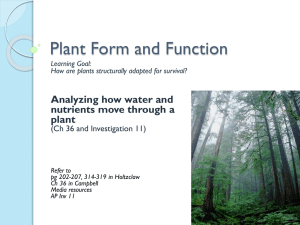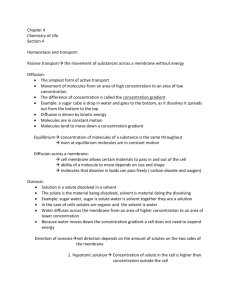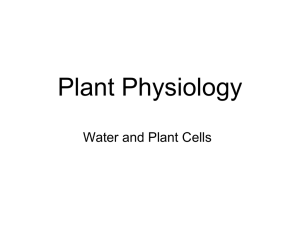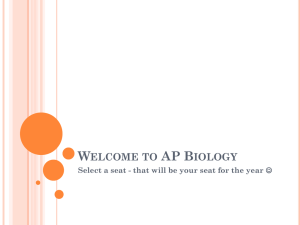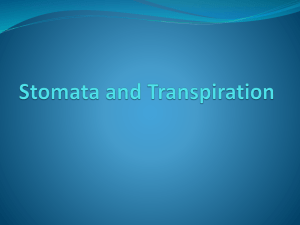chapter 36 – transport in vascular plants
advertisement
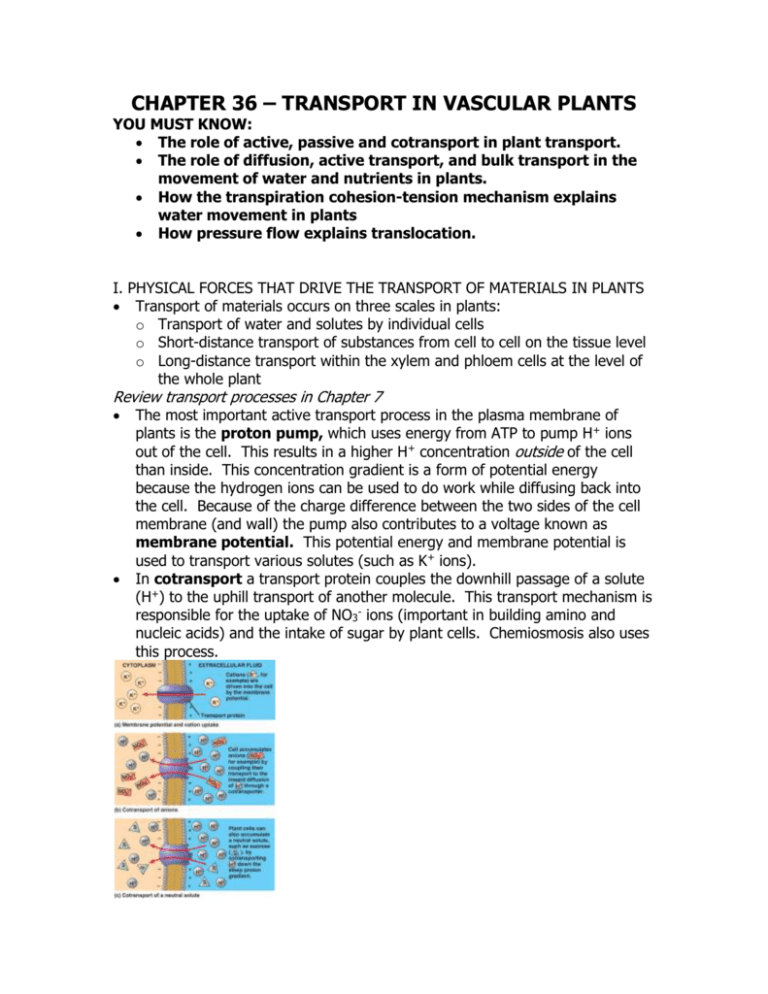
CHAPTER 36 – TRANSPORT IN VASCULAR PLANTS YOU MUST KNOW: The role of active, passive and cotransport in plant transport. The role of diffusion, active transport, and bulk transport in the movement of water and nutrients in plants. How the transpiration cohesion-tension mechanism explains water movement in plants How pressure flow explains translocation. I. PHYSICAL FORCES THAT DRIVE THE TRANSPORT OF MATERIALS IN PLANTS Transport of materials occurs on three scales in plants: o Transport of water and solutes by individual cells o Short-distance transport of substances from cell to cell on the tissue level o Long-distance transport within the xylem and phloem cells at the level of the whole plant Review transport processes in Chapter 7 The most important active transport process in the plasma membrane of plants is the proton pump, which uses energy from ATP to pump H+ ions out of the cell. This results in a higher H+ concentration outside of the cell than inside. This concentration gradient is a form of potential energy because the hydrogen ions can be used to do work while diffusing back into the cell. Because of the charge difference between the two sides of the cell membrane (and wall) the pump also contributes to a voltage known as membrane potential. This potential energy and membrane potential is used to transport various solutes (such as K+ ions). In cotransport a transport protein couples the downhill passage of a solute (H+) to the uphill transport of another molecule. This transport mechanism is responsible for the uptake of NO3- ions (important in building amino and nucleic acids) and the intake of sugar by plant cells. Chemiosmosis also uses this process. A. Water Potential Plants must balance water uptake and water loss to survive. Water moves by osmosis in and out of the cells. In plants it is more complicated to predict which direction water is moving to because of the presence of the cell wall. In the case of plants pressure and solute concentration together determines the direction of water movement. The combined measure of solute concentration and physical pressure are incorporated into water potential (abbreviated with the Greek letter psi, Ψ). Water potential determines the direction of movement of water. Free water that is not bound by solute or by surfaces always moves from the higher water potential region to the lower water potential region if there is no barrier to its flow. The unit of water potential is megapascals (MPa). Pure water has a water potential of zero if the container is open to the atmosphere, under standard conditions. The equation for water potential shows both of its components: Ψ = Ψs + Ψp Where Ψs is the solute potential and ΨP is the pressure potential. Solute potential of a solution is proportional to the number of dissolved solute molecules. Because solutes bind to water molecules and lower the capacity of water molecules to do work, adding solute molecules to water always lowers water potential. Because pure water has a zero water potential, solutions always have a negative solute potential. Pressure potential is the physical pressure on a solution. Pressure potential can be both positive and negative relative to atmospheric pressure. The pressure potential in living cells is usually under positive pressure. This positive pressure that presses the plasma membrane against the cell wall is called turgor pressure. B. Analysis of Water Potential in an Artificial System C. Part a: The membrane that separates the two sides of the U-tube is permeable to water but not to solutes. If one side is filled with pure water and the other side is filled with a 0.1M solution, the net water movement will be toward the solution from the pure water, because water always moves from higher water potential to the lower water potential area. Part b: If a pressure of 0.23 MPa is applied to the solution that the water potential is raised to 0 MPa. There will be no net flow between the two sides. Part c: If the pressure is further increased to 0.3 MPa than the solution has a water potential of +0.07 MPa. This solution will actually lose water to the pure water part of the U-tube. Part d: If the plunger would be pulled back on the pure water side, it would create a negative pressure and water would move to the pure water side. In plant cells, if a plant cell is limp (flaccid) it would have a ΨP of 0 and if it is sitting in a more concentrated environment, the cell would lose water and would plasmolyze. However, if the plant cell is in pure water, it would gain water and become turgid until the cell wall would produce enough pressure to compensate for the concentration difference and Ψ = 0. Turgor pressure is an important tool of plant support in nonwoody plants. Major Compartments of Vacuolated Plant Cells: The cell wall helps to maintain the cell’s shape The plasma membrane is a barrier between the cell wall and the cytosol. Mature plant cells also have vacuoles that are surrounded by the vacuolar membrane (tonoplast) – regulates molecular traffic between the cytosol and the vacuolar contents (cell sap). Proton pumps move hydrogen ions into the vacuole and other ions will follow the H+ ions by cotransport (chemiosmosis). In most cells the cytoplasm and the cell wall is continuous from cell to cell. The cytoplasmic continuum is formed by plasmodesmata and is called symplast. The continuum formed by the cell wall is called apoplast. The vacuole is independent from the other cells. D. Short-distance Transport Within the plant tissues, water and mineral can move from cell to cell (from the root hair to the vascular tissue) in three ways: o Apoplastic route – substances move across the cell wall from one cell to the next. o Symplastic route – substances can move on the cytoplasmic route, so they have to cross only one cell membrane and than flow from one cell to the next via the cytoplasm. o Transmembrane route – substances can move across the cell wall and cell membrane of one cell than the next one, so the plasma membrane needs to be crossed repeatedly. A. Long-Distance Transport Bulk flow – is the movement of a fluid driven by pressure Diffusion is not efficient enough to perform bulk transport so other forces act in these cases – see later in this chapter. II. ABSORPTION OF WATER AND MINERALS FROM THE SOIL Mineral ions from the soil can get into the root of plants by three different ways: o Diffusion – if the concentration of certain ions is lower inside of the root hair cells, they can simply diffuse into the root hair cells from the soil o With the help of fungal hyphae – Some plants live in a symbiotic relationship with fungi and use fungal hyphae to increase the surface of the root even more. This combination of plant root and fungal fibers are called mycorrhiza. The fungus benefit from a constant supply of sugar (organic nutrients) while the plant benefit from the increased surface area that the fungal hyphae provide, they also excrete growth factors and antibiotics. o The flow of water into the root can also carry ions passively in dissolved form. Root hairs expend the surface area of roots. These roots hairs that are extensions of single epidermal cells absorb water and dissolved minerals. Watery solution has to be transported from the soil to epidermal cells to cortex of the root to the xylem (water-conducting vascular tissue) The plasma membrane of the xylem cells are selectively permeable (only certain materials can go through them) There are 2 possible routes to the xylem: o Intracellular route (symplastic route): Via cell interiors through plasmodesmata (continuum of cytoplasm between cells), so crossing cell walls and cell membranes in only once necessary. o Extracellular route (apoplastic route): The solution moves within the hydrophilic walls and extracellular spaces but does not enter the cytoplasm of the cortex or epidermis cells. The Casparian strip (a waxy layer of the endodermis) stops these substances from entering the xylem, so they need to travel through the endodermal cell by the intracellular route. o In real life solutions are transported by a mix of these two routes. III. LONG TERM TRANSPORT OF WATER AND MINERALS The transport takes place in the xylem and moves substances from the roots to the shoot system to the veins of each leaf. Plants lose water by transpiration – the loss of water vapor from leaves and other aerial parts of the plant. The transpired water is replaced by water that is absorbed by the roots. Two forces contribute to water transport: a. Root pressure – Water flows in from the root cortex and pushes the water that is already there upwards, toward the leaves. This water flow is due to the accumulation of minerals in the vascular cylinder that lowers water potential there and pulls water in. In smaller plants this Figure 36.13 pushing force of water results in guttation – the collection of water droplets on the leaves early in the morning. This force is especially important at night when transpiration is very low or zero because of the low temperature. But this force is too small to push water up higher than a few meters. b. Transpiration-Cohesion-Tension Mechanism -- a pulling force that is created by the loss of water from the leaves and other aerial parts of the plant. Water molecules leave the plant through the stoma of the leaf by diffusion because when the stoma is open, water concentration is higher in the plant cells than in the surrounding atmosphere. Because water molecules are polar, they are attracted to each other by hydrogen bond (cohesion). These water molecules form continuous strings of water from the root to the leaves. In the meantime, adhesion sticks molecules and ions of different kinds together. This force adheres water molecules to cellulose molecules in the xylem cell wall. As water molecules transpire away from one end of the string of water molecules because of the concentration gradient, cohesion and adhesion pulls the remaining water molecules upwards from the root. These processes do not require energy from the plant, they are all extended by physical properties of water and the surrounding molecules. Plant transpiration site (great) : http://croptechnology.unl.edu/animation/transpiration.swf I. STOMATA AND TRANSPIRATION Stomata are used to take in CO2 from the environment. The high surfaceto-volume ratio of leaves help to take in more CO2 for photosynthesis. However, this process enhances water loss by transpiration. Opening and closing stomata somewhat lowers the rate of evaporation but even when the stomata are closed, they still evaporate water. Factors increasing the rate of transpiration: higher temperature, wind, dry air. Factors decreasing the rate of transpiration: lower temperature, cuticle, humidity A. Mechanism of stomatal opening and closing: Opening: guard cells take in water from neighboring cells by osmosis, they become turgid and bowed. Guard cells can take in water because they accumulate K ions by active transport from neighboring cells – negative water potential inside the guard cells. The negative water potential will pull water in from the surrounding cells. The energy for the active transport is provided by proton pumps and the cotransport of H ions. Closing the stomata: guard cells lose K ions to the neighboring epidermal cells and water will passively follow the potassium ions because of the positive water potential that in created inside the guard cells. Stomata can also be opened if CO2 is depleted from the air spaces under the stomata. Circadian rhythms – Stomata are open in a regular rhythm during the day and closed at night. Environmental stresses can cause the stomata to close during the day (water deficiency) B. Xerophyte adaptations: Xerophytes – plants that adapt to dry conditions There are various leaf modifications that help plants to survive dry conditions (thick cuticle, small leaves, hair on the leaves, depressions for the stomata) The C4 and CAM photosynthetic processes are also adaptations II. MOVEMENT FROM SUGAR SOURCES TO SUGAR SINKS (MOVEMENT OF ORGANIC SUBSTANCES) Organic materials are transported in the sieve-tube members of the phloem. Sucrose is the most important organic material that is transported in the phloem but amino acids, minerals and hormones are also transported in the phloem sap. The direction in which the phloem sap travels varies depending on the location of the organic material. Sugar source – is the plant organ that is a net producer of sugar (leaf, storage root etc.) A sugar sink – is a consumer of the sugar that needs to receive sugar from the source (growing buds, stems, fruits). The sugar sink usually receives sugar from the nearest source. Sugar must be loaded into the sieve tube members before it can be transported. It usually moves through the plasmodesmata of neighboring cells via the symplast, but in some plants they also use the apoplast route. Cotransport with H ions move the sugar into the sieve tube members of the phloem. The sugar concentration is always higher at the sugar source than at the sink so it will move in the phloem from the high to the lower sugar concentration area. Water follows by osmosis. The movement is sped up by positive pressure that is created by water from the xylem. The high pressure will press the water with the sugar toward the sugar sink where the water exits back to the xylem. This process that enhances sugar flow is called pressure flow. http://academic.kellogg.cc.mi.us/herbrandsonc/bio111/animations/0032.swf http://bcs.whfreeman.com/thelifewire/content/chp36/36020.html


